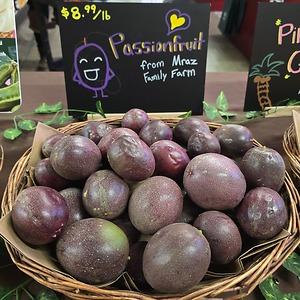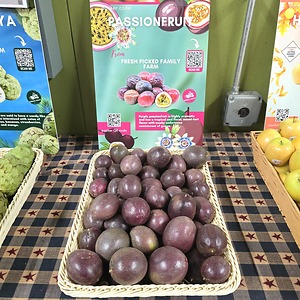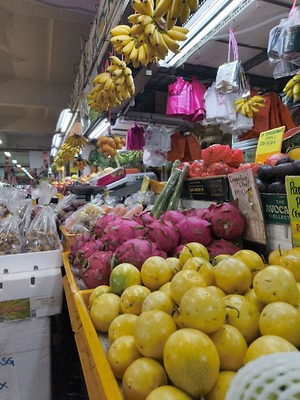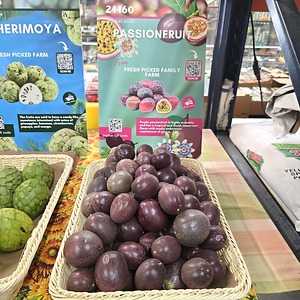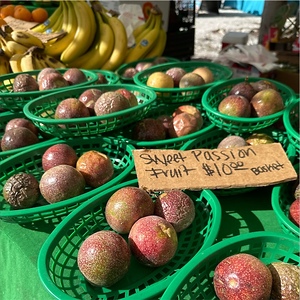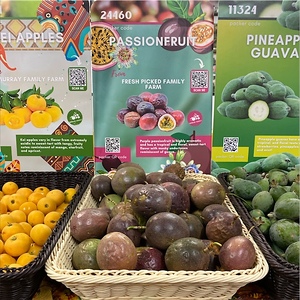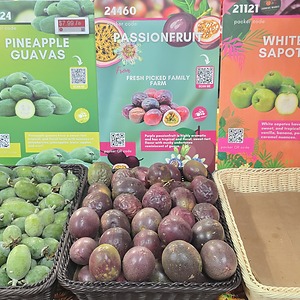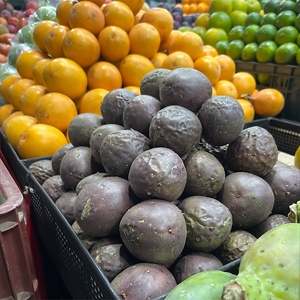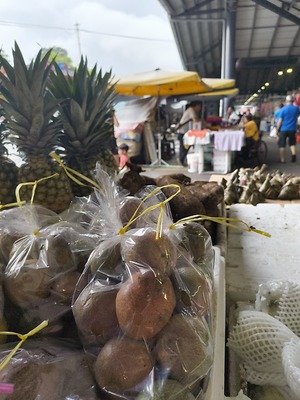


Purple Passionfruit
Estimated Inventory, 36 ct : 10.64
This item was last sold on : 04/17/25
Description/Taste
Purple passionfruit is slightly smaller than yellow passionfruit, averaging 5 to 7 centimeters in diameter, and has a round to oval shape with curved ends. The skin is smooth, waxy, and purple to dark red when young, developing darker hues with a leathery, dimpled, and wrinkled consistency with maturity. Underneath the surface, there is a white and spongy, inedible pith encasing a seed cavity. The flesh, also known as the pulp, consists of small and edible black seeds surrounding by a yellow to orange sack that is aqueous, slippery, and succulent. Purple passionfruit is highly aromatic and has a tropical and floral, sweet-tart flavor with musky undertones reminiscent of guava.
Seasons/Availability
Purple passionfruit is available year-round, with a peak season in the spring through late summer.
Current Facts
Purple passionfruit, botanically classified as Passiflora edulis, is the fruit of a climbing vine belonging to the Passifloraceae family. The sweet-tart, seedy fruits are native to South America and have become widely naturalized in tropical and subtropical climates around the world. There are two main commercial groupings of passionfruit that are globally cultivated, Purple passionfruit and yellow passionfruit, and within these types, there are many different cultivars with varying flavors and appearances. Purple passionfruit is primarily used for fresh consumption as it has a sweeter taste, while yellow varieties are cultivated for industrial juice processing. Passionfruit is known by many names, including Lilikoi in Hawaiian, Granadilla in Spanish, Maracuja in Portuguese, Fakihat Aleatifa in Arabic, Grenadille in French, and Krishna Fal in Hindi. The aromatic fruits are highly favored for their zesty, tropical taste and have become an exotic flavoring popularly incorporated into baked goods, cocktails, and desserts.
Nutritional Value
Purple passionfruit is a good source of vitamins A and C, which are antioxidants that can help reduce inflammation within the body and boost the immune system. The fruits also contain some potassium, phosphorus, iron, and folate. The seeds found within the flesh are an excellent source of fiber, which stimulates and regulates the digestive tract. Beyond the fruits, Purple passionfruit flowers have been used for centuries as a medicinal supplement to reduce symptoms associated with insomnia, asthma, anxiety, and menopause.
Applications
Purple passionfruit is prized for its sweet and tangy, jelly-like pulp, which is best suited for both raw and baked preparations. The fruit can be sliced in half, removed from the rind with a spoon, and consumed straight, out-of-hand. Both the pulp and seeds are edible, and for a less tart flavor, sugar, cream, or chile powder and lime can be added before serving. Purple passionfruit is popularly used as a topping over ice cream, yogurt, cakes, and fruit salads, or it can add tropical undertones into ceviche, soups, sauces, syrups, jams, and jellies. The flesh can also be strained through a cheesecloth to remove the seeds, and the juice can be blended into smoothies, fruit punches, soft drinks, and cocktails, or mixed into cheesecakes, cookies, shaved ice, mochi, malasadas, and frostings. In addition to the fruits, passionfruit flowers and leaves are edible and can be used fresh as garnishes or dried for teas. Purple passionfruit pairs well with fruits such as banana, orange, watermelon, coconut, and mango, honey, dark chocolate, and almonds. Purple passionfruit should be stored at room temperature until fully ripe. Mature fruits will be wrinkled, developing thin, brittle skin, and will appear darker in color. Once ripe, they can be stored in the refrigerator for up to one week.
Ethnic/Cultural Info
The name passionfruit can be traced back to the 16th century when Spanish missionaries first encountered the climbing vines in Brazil. Purple passionfruit vines produce large white flowers with intricate purple, green, black, and yellow detailing. Spanish missionaries believed the flower's appearance resembled icons of the crucifixion of Christ, also known as “the Passion.” These details on the flowers were used by the missionaries as visual symbols to share the crucifixion story with native peoples, and the elements included the stigmas of the flower representing three nails, the corona as the crown of thorns, the five stamen as the five wounds, and the five petals and five sepals as the ten apostles. After the missionary’s use of the flowers, the flowers became known as Flor das Cinco Chagas or the “Flower of The Five Wounds,” and eventually, the entire plant was generally labeled the passion plant, leading to the name passionfruit. In the modern-day, passionfruit can be spelled multiple ways, depending on the region of the world, and both passion fruit and passionfruit are considered grammatically correct spellings.
Geography/History
Purple passionfruit is native to tropical forests spanning across Southern Brazil, Northern Argentina, and Paraguay and has been growing since ancient times. The fruits were localized to South America until the arrival of Spanish missionaries in the 16th century, and later in the 19th century, the seeds were spread to Australia, Hawaii, Africa, Asia, and Southeast Asia. By the 20th century, Purple passionfruit was naturalized throughout most of the subtropical and tropical regions of the world and was also introduced to Israel for small-scale cultivation. Today Purple passionfruit is grown commercially in India, New Zealand, the Caribbean, Brazil, Columbia, Ecuador, Indonesia, Peru, Australia, Israel, Africa, and in the United States in Florida, Hawaii, and California. The vines are also grown in home gardens, cultivated for their fruits, leaves, and flowers, and can be found in gardens around the world.
Featured Restaurants
Restaurants currently purchasing this product as an ingredient for their menu.
| Side Bar | San Diego CA | 619-348-6138 |
| Salt and Lime | Del Mar CA | 858-926-8582 |
| Convention Center East | San Diego CA | 619-525-5832 |
| Juniper & Ivy | San Diego CA | 858-481-3666 |
| Cody's La Jolla | La Jolla CA | 858-459-0040 |
| Jeune Et Jolie | Carlsbad CA | 858-231-0862 |
| Georges at the Cove | San Diego CA | 858-454-4244 |
| Donation 3 | San Diego | 619-295-3172 |
| Fishery | San Diego CA | 858-272-9985 |
| Embassy Suites Downtown | San Diego CA | 619-481-9349 |
| Catania La Jolla | La Jolla CA | 619-884-5350 |
| Bridges at Rancho Santa Fe | Rancho Santa Fe CA | 858-759-6063 |
| Boujiemana | San Diego CA | 415-710-0510 |
| US Grant Hotel Grill | San Diego CA | 619-232-3121 |
| Extraordinary Desserts | San Diego CA | 619-294-2132 |
| Bernini's Bistro | La Jolla CA | 858-454-5013 |
| Hotel La Jolla - Sea & Sky | La Jolla CA | 858-459-0261 |
| Alila Marea Beach Resort (Pastry) | Encinitas CA | 805-539-9719 |
| Brigantine Pt Loma | San Diego CA | 619-224-2871 |
| The Handmade Chef Meal Prep Co. | San Diego CA | 619-368-3705 |
| US Grant Hotel Main | San Diego CA | 619-232-3121 |
| Extraordinary Desserts Union St. | San Diego CA | 619-294-7001 |
| Mabel's Gone Fishing | San Diego CA | 619-228-9851 |
| Miho | San Diego CA | 619-365-5655 |
| Mister A's Pastry | San Diego CA | 619-239-1377 |
| Yoann Taboyan, Personal Chef | San Diego CA | 347-277-1958 |
Recipe Ideas
Recipes that include Purple Passionfruit. One







